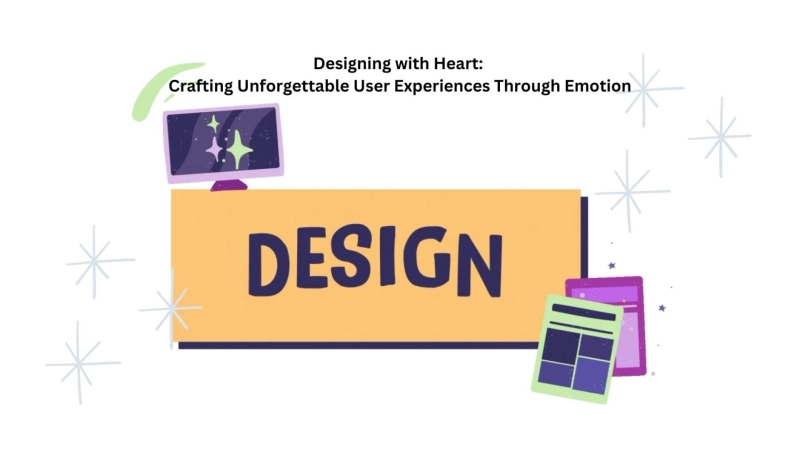In the world of design, a beautiful truth is emerging: emotions matter. Design is no longer just about creating pretty websites or functional apps; it's about touching hearts, sparking joy, and leaving lasting impressions.
Welcome the emotional design, where every pixel, interaction, and word infuse feeling.
Understanding Emotions in Design:
Emotional design is a multifaceted approach that integrates human emotions into the design process. As designers, we recognize that our users are not passive observers but complex beings with thoughts, feelings, and desires. By tapping into these emotions, we can create experiences that resonate deeply with users, forging stronger connections and driving engagement.
Why Emotions Matter in Design:
Emotions play a pivotal role in shaping user behavior and perception. Research has shown that emotions influence decision-making processes, memory retention, and brand loyalty.
When users feel positive emotions such as joy, excitement, or trust while interacting with a product or website, they are likelier to form a strong emotional bond and become loyal advocates. Conversely, negative emotions such as frustration or confusion can lead to dissatisfaction and abandonment.
Elements of Emotional Design:
Emotional design encompasses various elements that evoke and amplify emotions in users:
Visuals: Visual elements such as colors, imagery, and typography can evoke specific emotions and set the tone for the user experience. Warm colors like red and orange evoke passion and energy, while cool colors like blue and green may convey calmness and tranquility. Imagery plays a crucial role in storytelling and evoking empathy through captivating photographs or evocative illustrations.Interactions: Interactions are where design truly comes to life, offering opportunities to engage users emotionally. Thoughtful micro-interactions, smooth animations, and responsive feedback can make users feel valued and understood. By anticipating user needs and providing delightful interactions, we can create moments of joy and surprise that leave a lasting impression.Copywriting: Words can evoke emotions, shape perceptions, and drive action. Effective copywriting goes beyond conveying information; it tells a story, stirs emotions, and connects with users personally. Using empathetic language, persuasive messaging, and compelling storytelling, we can create experiences that resonate deeply with users and inspire action.Empathy: Perhaps the most critical element of emotional design is empathy—the ability to understand and share the feelings of others. Empathy lies at the heart of user-centered design, guiding us to design with the user's needs, preferences, and emotions in mind. By putting ourselves in the shoes of our users, we can create experiences that are more intuitive, empathetic, and impactful.Practical Strategies for Emotional Design:
Here are some practical strategies for incorporating emotional design into your projects:
User Research: Start by understanding your users' needs, motivations, and pain points through qualitative research methods such as interviews, surveys, and usability testing. By gaining insights into users' emotions and behaviors, you can design experiences that resonate with them on a deeper level.Persona Development: Develop user personas that capture the emotional attributes of your target audience, including their goals, values, and pain points. Personas humanize the design process, helping you empathize with your users and design with their needs and emotions in mind.Moodboarding: Use mood boards to explore different visual styles, themes, and emotions you want to evoke in your design. Mood boards can help align stakeholders on the desired emotional tone for the project and serve as inspiration throughout the design process.Prototype and Iterate: Build interactive prototypes to test how design elements evoke emotions and iterate based on user feedback. Prototyping allows you to experiment with other interactions, animations, and visual styles to create experiences that resonate with users.Stay Human-Centered: Remember that behind every click and scroll is a natural person with thoughts, feelings, and dreams. Design with empathy, authenticity, and heart; you'll create experiences that touch lives and leave a lasting impact.Case Studies: Examples of Emotional Design Done Right:
Let's take a closer look at some real-world examples of emotional design in action:
Headspace: The meditation app Headspace uses calming colors, soothing imagery, and empathetic language to create a sense of serenity and relaxation. The app helps users feel supported and motivated to practice mindfulness through playful animations and encouraging messages.Airbnb: Airbnb's website and mobile app are designed to evoke feelings of adventure, discovery, and belonging. The platform inspires users to explore new destinations and create memorable travel experiences by showcasing vibrant imagery, personalized recommendations, and social proof.Ultimately, emotional design is about more than just pixels and code—it's about humanity. It's about understanding what makes us tick, what brings us joy, and what moves us to action.
By infusing our designs with empathy, authenticity, and heart, we can create experiences that look good and work well, touch souls, and leave a mark on the world.
So, let's design with heart and craft experiences that make people smile, laugh, and maybe even shed a tear or two. After all, isn't that what it's all about?


